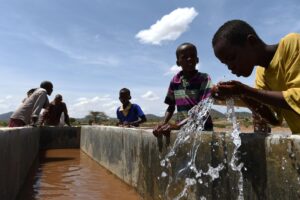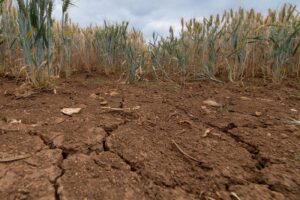Mexican citizens will go to the polls on 2 June 2024 to elect a new president, a new legislature and thousands of other local government officials.
Three candidates – two of whom are women – are contending to succeed the current leftwing president Andrés Manuel López Obrador. This could be the first time a woman is elected as president of Mexico.
In Mexico, presidential candidates can be put forward by a coalition of different political parties that share common goals and agendas.
Leading candidate in the polls Dr Claudia Sheinbaum represents a leftwing coalition, which includes Obrador’s ruling party, the National Regeneration Movement (Morena).
Xóchitl Gálvez represents several right and centre-left opposition parties, including the National Action Party. Jorge Álvarez Máynez is the centre-left party Citizen’s Movement candidate.
Mexico – a country with more than 126 million inhabitants and considered the second largest economy in Latin America, after Brazil – had the world’s 11th largest greenhouse gas emissions in 2018. (See Carbon Brief’s Mexico profile for more.)
Within the G20, Mexico is the only member that has not set a net-zero target. The country still strongly depends on oil, gas and coal. It faces several challenges in decarbonising its economy, implementing its national climate law and protecting its biodiversity through, for example, conserving its biodiversity agency.
In the interactive grid below, Carbon Brief compares the three presidential candidates’ proposals on energy, climate and biodiversity, based on manifestos, official webpages and other key official documents.
Each entry in the grid represents a direct quote from one or more of these documents.
Where does the country stand?
In its updated pledge to the UN about its climate actions and ambitions – its nationally determined contribution – Mexico says it contributes 1.3% of global greenhouse gas (GHG) emissions.
The country aims to cut its greenhouse gas emissions to 35% below a business-as-usual baseline by 2030, rising to 40% with international financial support.
The document says that emissions in 2020, not including land-based removals, stood at 804m tonnes of carbon dioxide equivalent (MtCO2e), with this rising to 991MtCO2e under the no-mitigation baseline.
This means hitting the lower target would entail cutting emissions to 25% below 2020 levels and the conditional goal a 35% reduction from the same starting point.
Its 2030 baseline is 991MtCOe with no mitigation efforts by the same year – reaching up to 40% of emissions reductions with international financial support.
Fossil fuels account for 86% of the total energy supply, while renewables make up only 8%.
In 2022, research and NGO partnership Climate Transparency concluded that Mexico “needs to adopt policies to phase out the use of fossil fuels [for example] coal and heavy oil while also reducing the social inequality gap”.
Sandra Guzmán is general director at the Climate Finance Group for Latin America and the Caribbean (GFLAC) and member of México resiliente – a group of civil-society organisations that sent the presidential candidates a proposed climate plan for the country.
This election is particularly important because of the need to rapidly cut global emissions this decade, she tells Carbon Brief. Guzmán adds:
“This is the most important six-year period to achieve climate goals. If someone with no interest in climate change comes to power, we would disdain and discard any commitment that Mexico has made and we will hardly be able to get on the path to compliance.”
What are the proposals?
Dr Claudia Sheinbaum is the candidate of the “let’s keep making history” coalition, made up of the ruling leftwing party, the National Regeneration Movement (Morena), the Labour party and the Green party. She holds a PhD in energy engineering and was head of the government of Mexico City from 2018 to 2023.
Sheinbaum’s roadmap for 2024-2030 aims to “decarbonise the energy matrix as quickly as possible”. However, the 381-page document says her administration would be “in line” with Obrador’s energy policy, which is based on energy self-sufficiency through the strengthening of the state-owned oil company Petróleos Mexicanos (Pemex), and the rehabilitation and acquisition of refineries. As well as the roadmap, the coalition’s manifesto does not mention any reference to net-zero.
Additionally, she has recently unveiled a plan to invest more than $13bn in new energy generation projects through 2030, according to Reuters. This would include increasing wind and solar power generation, as well as modernising five hydroelectric plants.

During the second presidential debate aired on Sunday 28 April, Sheinbaum restated her proposal to boost renewable energy sources. This includes domestic solar panels as well as growing electric transportation, while relying on gas and more combined-cycle plants for the energy transition.
The “let’s keep making history” candidate currently holds a substantial lead in the polls, but it is less clear whether her coalition will achieve the two-thirds majority in the legislature that it would need to enact its desired constitutional reforms.
Xóchitl Gálvez is the coalition candidate of several right and centre-left opposition parties, including the National Action Party, Institutional Revolutionary Party and Party of the Democratic Revolution. She is a computer engineer, an entrepreneur, a former mayor of Miguel Hidalgo borough in Mexico City from 2015 to 2018 and a former senator from 2018 to 2023.
Her coalition’s manifesto outlines a decarbonisation plan and pledges resources to encourage local and national energy transition plans. One of her most prominent energy proposals, outlined on her official webpage, is for the country to reach “net-zero carbon emissions” by 2050.
In the television debate, Galvez reaffirmed her commitment to achieving net-zero emissions by 2050, making Pemex’s business model more efficient and promoting clean energy rounds and electricity auctions. In a new proposal, she suggested that 50% of energy should come from renewable sources by 2030.
Jorge Álvarez Máynez is the candidate of the centre-left party Citizen’s Movement. He was deputy of Mexico’s congress for 2015-2018 and 2021-2024.
The party’s political platform seeks to establish a deadline for phasing out the use of fossil fuels. His party says it is committed to energy transition and recognises that this will involve replacing fossil fuel revenues, suggesting revenues from lithium, wind and hydropower production will make up the shortfall. While the manifesto pledges more ambitious emissions-cutting targets, it does not mention net-zero.
During the debate, Máynez reiterated some of the proposals outlined in his manifesto. This included the importance of transitioning to clean energy sources, such as solar and wind power, changing an oil tax into a green tax for electromobility and public transport, and closing a refinery and thermoelectric plant. He said his administration would install solar panels in all schools and hospitals, and boost sustainable development in the country’s south.
Missing issues
The second presidential debate in Mexico was the first ever to include climate change and sustainable development as one of its thematic areas. The three candidates discussed their proposals on mitigation and energy transition, while adaptation was little mentioned.
Mexico is currently grappling with water scarcity and drought. From October last year to April this year, the country’s 210 dams recorded storage figures below historical averages, according to Mexico’s national water commission. It adds that almost 80% of the country is currently going through some level of drought, with the northwest and center regions having it the worst. All candidates recognised both problems in the debate.
Sheinbaum said she would implement a national water plan focused on modernising agricultural irrigation, and recycling and boosting new water sources, such as seawater desalination. She also would maintain the agroecology program Sembrando Vida, questioned by experts for its impacts on deforestation and communities, and for not having environmental indicators in Central America.
Gálvez proposed creating a tri-national agency between Mexico, the US and Canada to tackle forest fires. On water, she said her government would give financial resources to the national water commission and treat 100% of wastewater by 2040.
Máynez plans to double the budget for water infrastructure, including dams, aqueducts and leak repairs. He proposes new conditions for companies setting up in the country, as most water is currently concessioned to large companies.
Guzmán tells Carbon Brief that, when it comes to climate policies, the biggest gaps in the candidates’ proposals are on adaptation and finance. She criticises candidates for not seeing climate change as a cross-cutting issue and for not earmarking funds or tax reforms to address the matter.
Biodiversity, loss and damage and the Escazú agreement – an agreement ratified by 16 countries from Latin America and the Caribbean to protect environmental defenders – are also absent, according to Anaid Velasco, GFLAC Mexico country director and member of México resiliente.
She tells Carbon Brief that biodiversity is “crucial”, since the Kunming-Montreal Global Biodiversity Framework mandates countries to submit their national biodiversity strategies (NBSAPs) this year. Mexico “should be working on it”, she says.
The post Mexico election 2024: What the manifestos say on energy and climate change appeared first on Carbon Brief.
Mexico election 2024: What the manifestos say on energy and climate change
Climate Change
Analysis: Record UK wildfires have burned an area twice the size of Glasgow in 2025
Wildfires have scorched more than 40,000 hectares of land so far this year across the UK – an area more than twice the size of the Scottish city of Glasgow.
This is already a record amount of land burned in a single year, far exceeding the previous high, Global Wildfire Information System (GWIS) data shows.
It is also almost four times the average area burned in wildfires by this stage of the year over 2012-24 – and 50% higher than the previous record amount burned by this time in 2019.
The burned area overtook the previous annual record in April, BBC News reported at the time, and has continued to soar in the months since.
Major wildfires
The chart below shows that UK wildfires in 2025 so far have already burned by far the largest area of land over any calendar year since GWIS records began in 2012. The previous record year was 2019, followed by 2022, while 2024 saw the lowest area size burned.

Annual land area burned by wildfires across the UK from 2012 to 2025 (red), alongside the average area burned each year over 2012-24. Source: Global Wildfire Information System.
Climate change can increase the risk and impact of wildfires. Warmer temperatures and drought can leave land parched and dry out vegetation, which helps fires spread more rapidly. Climate change is making these types of extreme conditions more likely to occur, as well as more severe.
Fire services in England and Wales responded to 564 wildfires from January to June 2025 – an increase from 69 fires in the same period last year, the National Fire Chiefs Council (NFCC) said in a statement in June.
Most wildfires in the UK are caused by human activity, whether accidental or deliberate, according to the NFCC. Some common ignition sources are disposable barbecues, lit cigarettes and campfires.
Jessica Richter, a research analyst at Global Forest Watch, says that, while fires are also a key part of some ecosystems, climate change is the “major driver behind the increasing fire activity around the globe”. She tells Carbon Brief:
“As we see more fires, we’re going to see more carbon being emitted and that’s just going to be, for lack of a better phrasing, adding fuel to the fire.”

Examples of 2025 wildfires around Galloway (1) and Inverness (2) in Scotland, and a wildfire in Powys (3) in Wales. Source: FIRMS, MapTiler, OpenStreetMap contributors.
The UK has also recorded its highest-ever wildfire emissions this year, according to Copernicus, which was “primarily driven” by major wildfires in Scotland from late June to early July.
These were the largest wildfires ever recorded in the country, reported the Scotsman. They “ravaged” land in Moray and the Highlands in the north of the country, the newspaper added.
Scotland experienced an extreme wildfire in Galloway Forest Park in April, which was “so intense it could be seen from space”, the Financial Times said.
Elsewhere, in April, the Belfast News Letter reported that firefighters tackled almost 150 fires on the Mourne Mountains in Northern Ireland.
More recently, BBC News reported that firefighters in Dorset, England received “non-stop” wildfire calls in the first weekend of August, with one blaze “engulf[ing] an area the size of 30 football pitches”.
Wildfires have also caused devastation across many parts of Europe in recent weeks – including Albania, Cyprus, France, Greece, Spain and Turkey – as well as in the US and Canada.
The post Analysis: Record UK wildfires have burned an area twice the size of Glasgow in 2025 appeared first on Carbon Brief.
Analysis: Record UK wildfires have burned an area twice the size of Glasgow in 2025
Climate Change
DeBriefed 8 August 2025: Arctic heatwave; Climate anxiety deep-dive; France’s wildfire crisis
Welcome to Carbon Brief’s DeBriefed.
An essential guide to the week’s key developments relating to climate change.
This week
Global extremes
RECORD HEAT: Multiple countries experienced record heat this week. Nordic countries were hit by a “truly unprecedented” heatwave, where temperatures reached above 30C in the Arctic Circle and Finland endured three straight weeks with 30C heat, its longest heat streak in records going back to 1961, said the Guardian. Reuters reported that the United Arab Emirates (UAE) is facing “surging temperatures this summer”, following its hottest spring ever.
FIRE WEATHER: Some 81 million Americans were under air quality alerts as hundreds of wildfires burned across Canada and parts of the US, reported the Guardian. Meanwhile, a “massive” wildfire in California has “become the biggest blaze in the state so far this year” amid an intensifying heatwave, reported the Associated Press.
TORRENTIAL RAIN: A “torrent of mud” has killed at least four people in the northern Himalayan state of Uttarakhand, Reuters reported. According to the Times of India, “more than one cloudburst” hit the high-altitude district of Uttarkashi on Tuesday, triggering flash floods. It added that cloudburst risks in the Himalayan region are “projected to increase with climate change”. Meanwhile, Taiwan News said that “torrential rain in central and southern Taiwan over several days has left three dead, four missing, 49 injured and prompted 85 rescues”. Flash floods in a Myanmar-China “border town” have killed six people, according to the Straits Times.
Around the world
- COP30 CHAOS: After significant delays and pressure from a UN committee, Brazil has finally launched the official accommodation platform for COP30, Climate Home News reported. It added that “significant markups and sky-high prices remained”.
- MORE TARIFFS: Donald Trump has increased tariffs on imports from India to 50% as “punishment” for the country buying Russian oil, the New York Times reported.
- CORAL BLEACHING: The Guardian said that the Great Barrier Reef suffered its biggest annual drop in live coral since 1986 in two out of the three areas that are monitored by scientists..
- ENDANGERED: Top scientific advisers in the US have announced that they will “conduct an independent, fast-track review of the latest climate science” following the Trump administration’s move to repeal the “endangerment finding”, the scientific basis for federal climate regulations, Inside Climate News reported.
10,000
The number of glaciers in the Indian Himalayas that are “receding due to a warming climate”, according to Reuters.
Latest climate research
- Ecosystem restoration should be “pursued primarily” for biodiversity, supporting livelihoods and resilience of ecosystem services, as “climate mitigation potential will vary” | Nature Geoscience
- Attendees at the 2024 UN Environment Assembly “underestimate global public willingness to contribute 1% of their personal income to climate action” | Communications Earth & Environment
- Urban green spaces can lower temperatures by 1-7C and play a “crucial role in cooling urban environments” | Climate Risk Management
(For more, see Carbon Brief’s in-depth daily summaries of the top climate news stories on Monday, Tuesday, Wednesday, Thursday and Friday.)
Captured
Carbon Brief’s in-depth explainer unpacked the findings of a recent analysis on climate anxiety in more detail. The analysis explored 94 studies, involving more than 170,000 participants across 27 countries, to find out who is more likely to be affected by climate anxiety and what its consequences could be. The analysis suggests that women, young adults and people with “left-wing” political views are more likely to feel climate anxiety.
Spotlight
Heat and fire in France
This week, Carbon Brief explores how France’s media has covered the impacts of recent heatwaves and wildfires.
“We’re used to high temperatures, but we’ve never experienced heat like this [so] early in the year before,” a family member who lives in the Dordogne area of southwest France explained during a recent visit to the country.
Over recent weeks, there have been extreme heatwaves and fires across Europe, which has set new records across the continent, including in France.
France is now gripped once again by extremes. The country is currently experiencing yet another heatwave and this week faced its “largest wildfire in decades”, according to France24.
French climate scientist Dr Olivier Boucher, who is also the CEO of Klima consulting, told Carbon Brief:
“Climate change is already having visible and significant impacts in France. Heatwaves are becoming more frequent, more intense, and are occurring earlier in the season.
“This trend is accompanied by an increased risk of wildfires, particularly in southern regions, though other areas are also increasingly affected, putting the built environment at risk.”
Red alerts
In July, nearly 200 schools closed or partially closed as a result of high temperatures across the country.
Since the start of the summer, water reserves have been under close surveillance and multiple areas are facing water restrictions as a result of drought.
These water restrictions can include the use of tap water and violations can incur fines of €1,500 (£1,300). According to Le Monde, more than a third of the country is under drought alerts.
France has also experienced a “devastating summer” for fire outbreaks, according to FranceInfo. Traditional firework displays celebrating France’s Bastille day on 14 July were cancelled across the country due to forest fire risks, said Le Monde.

On 4 August, the local area of Aude, situated in the south-east, was placed under a red alert for forest fire risks.
Since then, there have been record-breaking fires in the region. BBC News reported that fires have “scorched an area larger than Paris”. The broadcaster added that the country’s prime minister, François Bayrou, linked the fires to global warming and drought, describing them as a “catastrophe on an unprecedented scale”.
Needing to adapt
Le Point explained how heatwaves impact grape vines and how winemakers have adapted their growing techniques by leaving more leaves on vines to protect the grapes from getting burned by the sun. However, it added that, “in the long run, it is necessary to think about more long-term modifications of viticulture”.
FranceInfo told the story of winegrowers losing their crops, worth millions of euros, in the recent fires in southern France, adding that it is “a real economic disaster for farmers affected by the flames”.
Le Monde interviewed French geographer Dr Magali Reghezza-Zitt, who described the nation’s preparations for dealing with climate change as inadequate. She told the newspaper:
“The gap between what needs to be done and the pace at which climate change is accelerating grows wider each year.”
Boucher added to Carbon Brief:
“All economic sectors are impacted by climate change, with agriculture among the most vulnerable. As the warming trend is projected to continue over the coming decades, adaptation will be essential – both through the climate-proofing of infrastructure and through changes in practices across sectors.”
Watch, read, listen
‘GRASSROOTS ALLIANCE’: A Deutsche Welle documentary explained how unions, activists and the India Meteorological Department have joined forces to protect Delhi’s informal workers from extreme heat.
NEW RULES: A Bloomberg article said that South Africa “will seek jail time, fines and higher taxes for breaches of proposed rules to govern carbon emissions” as part of new efforts to reduce the country’s dependency on coal.
SUSTAINABLE AI?: As the AI race intensifies, the Financial Times investigated if data centers can “ever truly be green”.
Coming up
- 5-14 August: Resumed talks on a global plastics treaty, Geneva, Switzerland
- 10-15 August: Ecological Society of America annual meeting | Baltimore, US
- 13-15 August: African Union-AIP water investment summit 2025 | Cape Town, South Africa
- 15 August: China Environmental Science Youth Academic Conference | Changsha, China
Pick of the jobs
- Save the Children, senior climate advisor | Salary: £61,500-£69,200. Location: London
- Irish Independent, environmental correspondent | Salary: Unknown. Location: Dublin
- Ember, interim managing director | Salary: £89,000-£100,000. Location: Remote
- British Antarctic Survey, seabird remote sensing data analyst | Salary: £41,344-£45,479. Location: Cambridge, UK
DeBriefed is edited by Daisy Dunne. Please send any tips or feedback to debriefed@carbonbrief.org.
This is an online version of Carbon Brief’s weekly DeBriefed email newsletter. Subscribe for free here.
The post DeBriefed 8 August 2025: Arctic heatwave; Climate anxiety deep-dive; France’s wildfire crisis appeared first on Carbon Brief.
DeBriefed 8 August 2025: Arctic heatwave; Climate anxiety deep-dive; France’s wildfire crisis
Climate Change
N.C.’s Democratic Congressional Delegation Condemns EPA Cancellation of Solar for All
They joined a chorus of critics across the country, where grantees in almost every state had been awarded funds to provide solar energy for 900,000 households in low-income and disadvantaged communities.
Democratic U.S. House members from North Carolina on Thursday condemned the Environmental Protection Agency’s plan to cancel $7 billion in grants for the Solar for All program, created under the Biden administration to expand access to solar energy in low-income and disadvantaged communities.
N.C.’s Democratic Congressional Delegation Condemns EPA Cancellation of Solar for All
-
Climate Change2 years ago
Spanish-language misinformation on renewable energy spreads online, report shows
-
Climate Change Videos2 years ago
The toxic gas flares fuelling Nigeria’s climate change – BBC News
-

 Greenhouse Gases1 year ago
Greenhouse Gases1 year ago嘉宾来稿:满足中国增长的用电需求 光伏加储能“比新建煤电更实惠”
-

 Climate Change1 year ago
Climate Change1 year ago嘉宾来稿:满足中国增长的用电需求 光伏加储能“比新建煤电更实惠”
-

 Carbon Footprint1 year ago
Carbon Footprint1 year agoUS SEC’s Climate Disclosure Rules Spur Renewed Interest in Carbon Credits
-
Climate Change2 years ago
Why airlines are perfect targets for anti-greenwashing legal action
-
Climate Change Videos2 years ago
The toxic gas flares fuelling Nigeria’s climate change – BBC News
-
Climate Change2 years ago
Some firms unaware of England’s new single-use plastic ban











